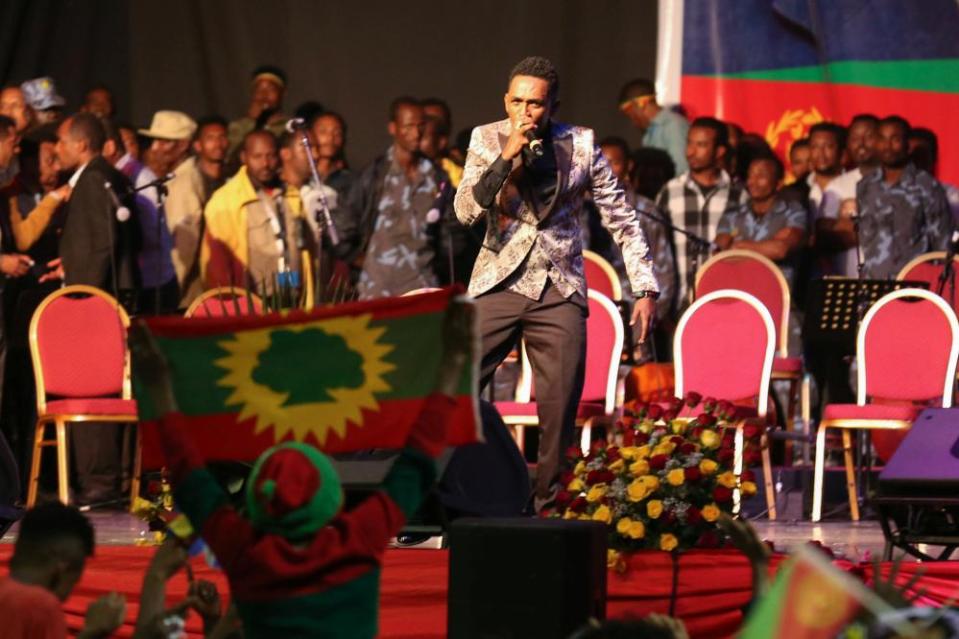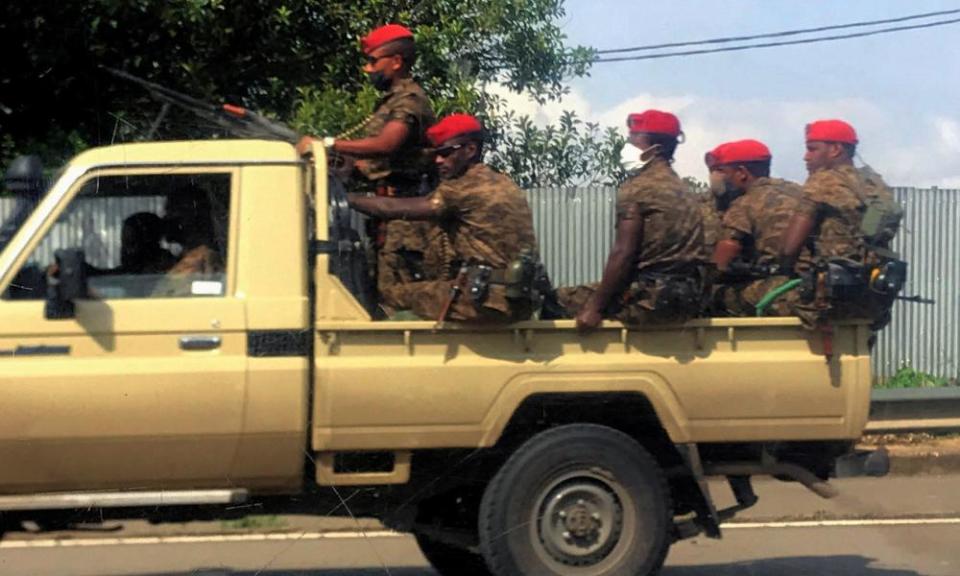How a musician's death unleashed violence and death in Ethiopia

The figure holding a gun stepped beside the car in which Haacaaluu Hundeessaa was sitting in Addis Ababa, and pulled the trigger. The cold-blooded killing on the night of 29 June cut short the young life of one of Ethiopia’s most popular musicians and activists. It was also the start of some of the most consequential few days in recent Ethiopian history.
Hours later, in the lakeside town of Ziway in Ethiopia’s Oromia region – from which Haacaaluu came – Selas Russell woke to the sound of gunfire and shouting. Soon a friend rang her. “Get up, grab your passport, leave your belongings and run for your life,” he told the Ethiopian-born British citizen who owns a hotel in the town.
As she and her staff fled, a mob mostly of young Oromo men and some women – carrying petrol, sticks, machetes and knives – stormed the compound and set it alight.

Thousands of demonstrators took to the streets across Oromia in the early hours of 30 June. They came to show their grief and anger at the death of the man who had supplied the soundtrack to the Oromo protest movement that began in 2014 and led to the appointment of Abiy Ahmed as prime minister in 2018. Abiy, a young Oromo from the ruling party, promised democracy for all and action to improve the lives of marginalised Oromos. A year later, he won the Nobel peace prize.
But things turned nasty. In Legatafo, a satellite town in Oromia near the capital, trucks arriving from the north were set on fire shortly after sunrise. Lake Amanu, a lorry owner and an ethnic Amhara, tells the Guardian how he, his driver and a police officer were chased by a gang carrying sticks, stones and machetes. “I ran away and hid under a bridge – they came after me,” he says. “They chase you if you don’t speak their language.”
Similar scenes took place elsewhere. In Addis Ababa, homes and businesses were vandalised and residents formed defence groups, in a few cases attacking Oromo residents or buildings belonging to them. Troops were deployed to restore order and the internet was switched off nationwide for more than a week. Thousands have been arrested, including key opposition leaders.
In some places the violence seemed spontaneous and random. Selas said some of her attackers appeared blind drunk. But in places such as Shashamane, 90km south of Ziway, it looked organised, with property belonging to non-Oromos quickly singled out for destruction.
“They knew what they were doing, they definitely knew,” says an Oromo resident of the city who asked to remain anonymous. Coordination and premeditation are “hallmark signs of ethnic cleansing”, Minority Rights Group International (MRG) noted in a statement (though there is no conclusive evidence of that). In the 24 hours after the assassination, hate speech and inflammatory messages circulated on social media and through a TV station formerly run by influential Oromo activist and politician Jawar Mohammed.
More than 160 people are said to have died in the unrest: some murdered – often in gruesome circumstances – by mobs; others shot by security forces. Houses, factories, businesses, hotels, cars and government offices were set alight or damaged across Oromia. More than 10,000 people fled their homes, according to the Oromia government communications bureau, out of fear or because their properties were destroyed.
What happened on 29 June and over the following days has further polarised the country, tearing at already fraying relations between the country’s two largest ethnic groups, Oromos and Amharas, and pitting opposing camps – pan-Ethiopians and ethnic nationalists – more implacably against each other.
It also took place in the context of a mooted democratic transition that opposition groups say is stalling, and in which the government’s use of force – ostensibly to target armed rebels in Oromia – has become increasingly widespread and indiscriminate. According to one well-connected Oromo activist, preparations for anti-government protests had been planned for several weeks before Haacaaluu’s murder.

Since then the social and political fractures underlying Ethiopia’s current crisis have widened. On the one side are those sympathetic to Abiy’s Prosperity party (PP) – which includes many Amharas – and the pan-Ethiopian nationalism with which it has become associated. On the other are those including many Oromos who are hostile to what they see as the centralising, culturally assimilating agenda of an Oromo prime minister they believe has betrayed them. Some, particularly those from smaller ethnic groups, remain in the middle – though that space is shrinking.
The government says Haacaaluu was murdered by Oromo nationalist militants as part of a wider plot to derail its reform agenda. The ruling party has also suggested that its rival in the northern region of Tigray, the Tigrayan People’s Liberation Front (TPLF), masterminded the conspiracy.
The TPLF dominated the ruling coalition, formerly known as the Ethiopian People’s Revolutionary Democratic Front, until Abiy took office in 2018. It has since abandoned former allies in Addis Ababa and joined the opposition, accusing the prime minister of planning to replace Ethiopia’s ethnic-based federal system with a more unitary state.
Both it and influential Oromo nationalist groups like the Oromo Liberation Front (OLF) deny involvement in either the murder or the unrest. “Our struggle is to create a country where people can speak freely. We don’t kill people because they speak their mind,” Kumsa Diriba, a commander of Oromo rebels in the region’s west, told Voice of America in an interview.
Some of the government’s opponents have sought to blame it and its pan-Ethiopian allies, claiming it was part of an orchestrated plan to justify further repression.
“Everyone is trying to frame what happened to fit their agenda,” says a local journalist in Adama who asked not to be named.
But the facts, such as they are known, frustrate simplistic narratives.
According to Ethiopia’s attorney general, ethnic Oromos number the highest among the official tally of deaths, which casts doubt on some of the more lurid allegations, including that of an attempted “genocide” against Amharas.

Some of the most deadly conflict took place in two parts of Oromia – Bale and Arsi – where intercommunal violence follows religious lines, pitting Muslim and Christian Oromos against each other. According to church authorities, 10 out of 38 Orthodox Christians killed in the unrest were Oromos.
In such places the dynamics of conflict can be highly localised, as different groups compete for power and resources amid fast-changing demographics. In Shashamane, for instance, the city’s religious composition has changed dramatically in recent decades, as large numbers of Muslim Oromos migrated there, fuelling tensions with Christians who once dominated the local economy.
In other towns, intercommunal conflict was minimal or nonexistent, with protesters instead clashing with security forces.
In Adama, 75km east of the capital, demonstrators burned the city’s finance and municipality offices. A doctor there told the Guardian that the local hospital treated 117 casualties, of which about 20 had bullet wounds. Some, from districts outside the city, were treated for burns, which the doctor said resulted from homes being set alight.
Buze Bulti, a 25 year-old who is five months pregnant, says her husband Gezahegn Tsegaye was shot dead on the morning after Haacaaluu’s murder.
“He was simply expressing his grief and protesting against the assassination of artist Haacaaluu Hundeessaa,” she tells the Guardian. “He was shot by a bullet in the shoulder and died while on the protest.

“My husband didn’t oppose the government,” she says. “He was a just a porter, a peaceful person; the kind of person who toiled to win his bread and to lead his life. No one has been held accountable for his killing so far and I didn’t see or hear anything about it. No one from the government has come yet and asked me about the killing of my husband.”
Other towns in Oromia, especially Haacaaluu’s birthplace, Ambo, witnessed similar scenes. In Addis Ababa, security forces acted mostly with restraint, using teargas and firing into the air to disperse crowds. In towns such as Shashamane and Ziway, local police did almost nothing to prevent the destruction until the army’s arrival later in the day.
“The police ignored it – they did nothing,” says the Amharic-speaking owner of Lucy Academy in Shashamane, Yohannes Wolde, whose schools, car and family home were destroyed. “I texted and called the mayor and head of security again and again but they never answered,” he says.
Shashamane’s mayor and security chief have since been arrested, along with more than 7,000 other suspects, according to officials. Among these are Jawar Mohammed – accused of inciting violence among other allegations – as well as several other influential opponents including Eskinder Nega and Lidetu Ayelaw from the pan-Ethiopian camp, who are accused of financing counterprotests. Dawud Ibsa, leader of the Oromo Liberation Front, is reportedly under house arrest.
In Adama, many of the protest leaders are now either in prison or in hiding. “[The authorities] are running after everyone,” says a 22-year-old old taxi driver who has changed his address and his phone number. “This government came to power mainly because of the blood of Oromo people – but it has ignored all our sacrifices and demands,” he says.
Speaking to a gathering of opposition leaders on 29 July, Abiy denied that the mass arrests constituted a political crackdown. “I do not personally decide who gets arrested and who gets released,” he said. He promised to continue pursuing what he called a “national consensus” in partnership with the opposition.
Yet with both sides ramping up hostilities, what remains of the space for dialogue and negotiation is beginning to slip from view.
“I do not question for one minute the violence in Oromia, the demagoguery of some Oromo militants. But the arrest of Oromo leaders like Jawar actually adds fuel to the fire. Oromo nationalism is now leaderless, on a radicalisation escalator, and that is very scary,” says researcher Rashid Abdi, a former director at the International Crisis Group.
“At the same time, the state breeds violence. Aggressive policing inflames, often acting as trigger for more violence.”


